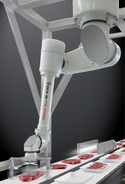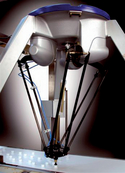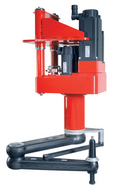Automatic appreciation
29 September 2007Nessan Cleary reports that the use of robotics is steadily increasing as their capabilities are more appreciated, although payback time is still a key issue, especially in the UK
In recent years, as the unique capabilities of robots have become more appreciated, so their use in packaging applications has increased. Able to work in the most challenging of environments, such as clean rooms, cold stores and foundries, they also carry none of the human “baggage” – they are tireless, loyal, cannot suffer from repetitive strain syndrome and never need a “comfort break”.
Dennis Juenger, marketing manager for the Bradman Lake Group, also points out that: “Robotics technology offers a far greater level of sophistication and flexibility. Especially when combined with vision system applications so that, for example, a random product flow can easily be distributed and placed in its allocated position. Fragile products can also be handled much more gently and precisely, offering a much improved product protection and product integrity guarantee.”
However, cost remains a major issue, and more particularly the time that it takes to repay the investment, with many vendors reporting that customers want to see payback times as short as six months. Stirling Paatz, managing director of Barr and Paatz, says that this issue seems to affect British companies more than their European counterparts: “I think that everybody’s under such pressure for short term numbers that they don’t feel that they want to expose themselves by spending that amount of money. But they are really forcing suppliers into compromising situations where they are not necessarily getting the best.”
That said, there is general agreement amongst all vendors that robot use will become more common within all sections of the packaging industry over the next few years. Dave Manby of AA Robotics says: “I think in the past two years people have started to wake up to robot use. Those left in UK manufacturing have suddenly started to realise that they will have to automate to keep it, because of cheaper labour and other costs elsewhere in the world.”
Most robotics solutions tend to start from a base robot that is then customised for a particular function and as Juenger points out, robotics applications will only work at their best with other systems when integrated by an expert, adding: “Where organisations in need of packaging expertise would have previously purchased machinery from different suppliers, the trend for designing, supplying, commissioning and maintaining entire packaging lines is increasingly strong.”
The growth of robot use in the packaging sector has led Kuka to open a new assembly facility at Halesowen in the West Midlands, close to its headquarters in Hereward Rise. As well as being used to assemble and test robot cells, the new unit also houses Kuka’s spares centre and after-sales service team.
One of Kuka’s most recent developments is the Arctic Robot, which is designed to work in temperatures from zero to minus 30ºC. Operated from a hand-held controller, it does not require any special protective suit or heater in its arm, eliminating any risk to the product quality from temperature fluctuations and the formation of ice on the frozen goods.
TM Robotics has updated its TH250 Scara machine with the TH250A, which it says is faster and more accurate and cost-effective. The machine features absolute encoders as standard, dispensing with the need for a home return function, a payload of up to 3kg, and repeatability of +/-0.01mm. It also has a built-in PLC which can control input/output equipment. This can be programmed from ladder sequence program, with optional devicenet or Profi-bus connectivity. There’s also an optional external switch pad which can be used to direct the robot through a sequence of movements, known as the Toshiba Machine teach pendant.
Bradman Lake concentrates on flexible automation using parallel axis robotic technology, mainly for top load cartoning systems, but also for pick-and-place feeding from a random source with vision technology. This includes the LJ-SRT robotic top loader which can be used to collate and pack items such as frozen chicken pieces, fish fillets and other prepared foods into cartons. A pick-and-place loading tool with multiple vacuum heads handles filled bags weighing up to1kg at speeds of up to 350/min, which can be increased to 400/min with an upgrade. The standard LJ/SRT loads some 24 bags/cycle, with more possible depending on product and collation.
High-speed robot for the food sector
A high-speed robot designed specifically for the food sector with a long reach of 900mm and “five axis flexibility” to accommodate horizontal or vertical product placement has been introduced by Fanuc Robotics. The
M-430iA/2F robot incorporates an
anthropomorphic arm to produce a large work envelope that allows it to quickly rotate or flip back on itself if required to cover an area of up to 1.8m diameter. The arm can be vertically mounted, providing clear access for maintenance, or base mounted.
Two high-speed heavy duty motors for each of the major axes, joints one two and three enable very high speed operation; using the “industry standard” benchmark test where the arm moves vertically 25mm, horizontally 300mm and down 25mm, the new robot achieves 120 and 100 cycles/min with 1 and 2kg payloads respectively and is sealed to IP67 standards with double seals to keep fluids out and grease in.
Bosch-Sigpack Systems says its Delta Robot gently and safely picks and places products at high speeds using minimal space. An integrated vision control system ensures maximum product quality. It recognizes various shapes and randomly ordered products or trays, and then sorts out faulty products. “The patented gripper technology ensures gentle and hygienic handling for delicate products in particular," says Roland Czuday, product manager of Delta Robot Systems.
The robots are said to be ideal for filling of assorted packages or feeding of products to flowwrappers and thermo machines. Sigpack says the modular and compact design allows for easy and fast cleaning of all components, including belts and grippers. In addition, it ensures quick format and program changes. Optional modules such as tray de-stacking, carton erecting and sealing machines can be added to these systems to broaden their use.
Meanwhile Kuka has developed a software control system for palletising boxes which has been adopted at the KP Foods factory in Billingham, Cleveland. The PalletTech software streamlines the round-the-clock palletising operation which comprises conveyors and a pair of 30m Güdel gantries fitted with bridges and vacuum gripper tools. The grippers can grab up to three boxes at a time, and can make three separate drops onto the pallets. It can palletise up to 32 different locations, and will also handle empty Chep pallets.
AA Robotics has created a robotics solution for Stanley Tools for its knife blade dispenser packaging. It uses Denso robots which AA Robotics’ Dave Manby says offer both high repeatability and lightweight. The robotic solution replaced a largely manual line and now loads and unloads components, and checks that those components meet the right specification. The blades from the blade-grinding machine are delivered in trays and automatically fed by conveyor into an upload station where they are prepared for loading into the cases. At the same time a strip of steel feeds into a press where it is cut to form the spring which is inserted in the case behind the blades. The case is then closed and checks are made to ensure the spring and blades are correctly inserted. A final robot palletises the cases, six layers deep with 28 cases to a layer, in a tote bin which is orientated correctly for final packaging.
This has allowed Stanley Tools to reduce stockholding and shorten its delivery times. Nick Vickers, plant manager of Stanley Tools explains: “With demand for replacement blades increasing and bearing in mind the health and safety aspects of manual handling, robotic automation was the obvious route to follow.” He added: “What's more, we have the flexibility to change the assembly and packaging process easily as products and demands change.”
In recent years the food packaging sector has started to adopt robotic solutions, as Barr and Paatz md Stirling Paatz, explains: “Robots are particularly suitable for use in picking items like yoghurt and chocolate biscuits where products come from lines on conveyors in a moderately random fashion and then need to be repacked into little matrix trays and mixed packs because you can use vision guidance.”
Fanuc, for example, recently installed 68 robots into a Spanish lettuce packing line which has helped to reduce labour demands by 80%. The lettuces are delivered direct from the fields to the plant in plastic containers stacked on a euro pallet. Robots are used to de-palletise them onto a packaging line conveyor and positioned and spaced, then sent to the robot cutting stations where the root is removed. Each lettuce is weighed and measured with those failing to match the parameters being rejected and the rest are packed into plastic trays. The system handles 400,000 lettuces a day, but has a maximum capacity of 550,000. José Sánchez, managing director of the El Dulze plant, says: “Reducing the amount of people has made everything more hygienic and damage to the lettuces caused by handling is now minimal. The robots have reduced rejects from 20% to 5%.”
In another example, Schubert has put together a packing line for Finlays, the UK’s largest packer of private label tea. The line uses 10 of Schubert’s TLM 2-axis robots including one which is specifically designed to gently shake the contents of each carton at the filling stage. It is being used to package five different pack sizes containing 80-240 bags that are fed from a series of teabag machines at the rate of 8,000/min. As the system is configured to process a variety of pack sizes, it means that changeover times are quick and the packaging line can be re-set within a few minutes.
Schubert launches new generation
Meanwhile, Schubert has equipped its TLM-F44 robot stations with the new TLM-F4 unit which is smaller, lighter and more efficient than the previous aluminium version. The new arm is made of carbon fibre and weighs 25% less than its predecessor, so it can achieve even faster cycle times.
In addition, the gears in the new unit are also designed to provide longer service life as they feature the same high-contact system typically used in the automotive industry.
The company has also launched a new generation of machine which it says features a series of improvements. As well as offering a wider variety of frame sizes, the redesign means operating control panels can be incorporated into safety door pillars, while a more streamlined conveyor structure allows better maintenance access to the packaging system.
Europe’s second-largest dairy producer, Arla Foods, has chosen Jorgensen Engineering to supply a turnkey line to handle cans of powdered product which includes its latest robotics technology. The line handles depalletizing of cans, single filing, cleaning of empty cans – including UV radiation – scoop inserting and subsequent filling. The whole process is controlled by a SCADA system communicating with the customer’s management control system to ensure centralised control of the entire plant and the machines.
RTS Flexible Systems has developed a robotic cell which it claims is the first ready-made pot handling solution for the food industry. It can be adapted to deal with any shape of pot and be easily integrated into the layout and operational requirements of most pot-filling operations. It picks inherently unstable pots reliably and places them in pre-formed plastic or card trays at rates of up to 160 pots/min, 24 hours a day. The RTS robotic cell is available in two variants, enabling pots to be picked at high speed directly from the pot filling machine, or to collate and pack pots downstream. It is also said to integrate easily with other devices, including an acetate denester, carton erector, tray labeller, metal detector or checkweigher.
Etienne Croquette, UK sales manager of Dairy and Confectionery Industries for RTS Flexible Systems says: “Typically, a production line has had to run on one pot shape for one order, then to switch to another. This can cost a lot in downtime. The alternative is to have dedicated lines, but this is only viable where demand for each type is continuous.”
The general consensus amongst suppliers is that robotics are developing to the point where they will soon challenge more conventional automated systems and, of course, a robot can easily be reprogrammed to do a variety of other tasks.
Contact details
AA Robotics
T: +44 (0)1296 314300; www.aarobotics.co.uk
Bradman Lake
T: +44 (0)1603 441000; www.bradmanlake.co.uk
Fanuc
T: + 44 (0)2476 639669; www.fanucrobotics.co.uk
Jorgensen Engineering
Tel.: +45 63 13 22 11; www.jorgensen.dk
Kuka
T: +44 (0)121 585 0800; www.kuka.com
Motoman
T: + 44 (0)1295 272755; www.motoman.co.uk
RTS Flexible Systems
T: +44 (0)161 777 2000; www.rtsflexible.com
Schubert
T: + 44 (0)1676 525825; www.schubertuk.co.uk
Sigpack Systems
T: +41 52 674 6654; E:roland.czuday@sigpacksystems.com
TM Robotics
T: +44 (0)1707 871535; www.tmrobotics.co.uk






